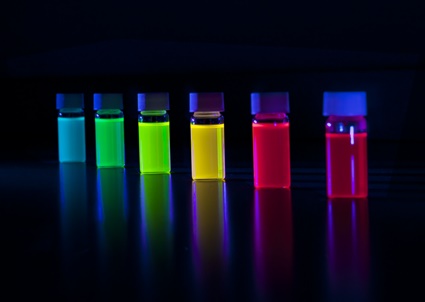QD Films for Photovoltaic Cells
Organic photovoltaic (OPV) cells are solar panels that are manufactured using organic light-converting materials such as polymers. Conventional solar panels use inorganic semiconductor materials to absorb visible wavelengths of light and convert it into direct current (DC) electricity, while certain semiconductors exhibit suitable bandgaps for converting either infrared or ultraviolet light into an electric current. This technology is one of the frontrunning supplies of clean, sustainable energy, but superior materials are required to optimize the absorptive and semiconducting properties of new and emerging OPV products.
Standard OPVs utilize single-junctions to attenuate light of specific bandwidths. These cells are manufactured using semiconductors that are incapable of converting light beyond their bandgaps, and as such, they only exhibit efficiency levels in the region of 5%. Multi-junction solar cells have attempted to address this issue by using multiple semiconductor materials in the formation of the panel surface – including quantum dot (QD) films.

The application of QD films to OPVs has enabled the production of finely-tuned solar cells with broader absorptive ranges and improved energy yields. This article will explore the use of QD films for OPVs in more detail:
What are QD Films?
Quantum dots are synthetic particles of nanometer dimensions with semiconducting and photoemissive properties. They can be fully customized to display specific bandgaps and electron energy characteristics, enabling the formulation of unique dispersions comprising QDs of multiple size ranges. These dispersions can be used to treat a substrate material. This is known as a QD film.
What do QD Films Do?
QD films have vastly improved absorptive properties over conventional semiconductors due to the finely tuneable nature of their synthetic processes. It is possible to customize the bandgap of QD films to include frequencies of light that are difficult – if not impossible – for other materials to harness.
A large part of the solar energy that reaches earth is on the ultraviolet spectrum, which is traditionally difficult for semiconductors to absorb. QD films, however, enable OPVs to convert ultraviolet light to visible light as easily as any other wavelength, simply by manipulating the size and structure of the QD nanocrystals used in its dispersion.
This characteristic has significant promise in the formation of maximum efficiency OPV cells to support the world’s growing energy demands.
QD Films from Avantama
Avantama is a leading supplier of unique nanoparticles and solutions for a broad range of applications.
If you would like any more information about producing QD films, please do not hesitate to contact us.